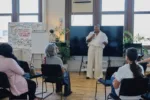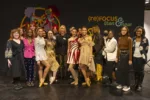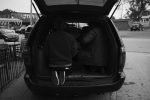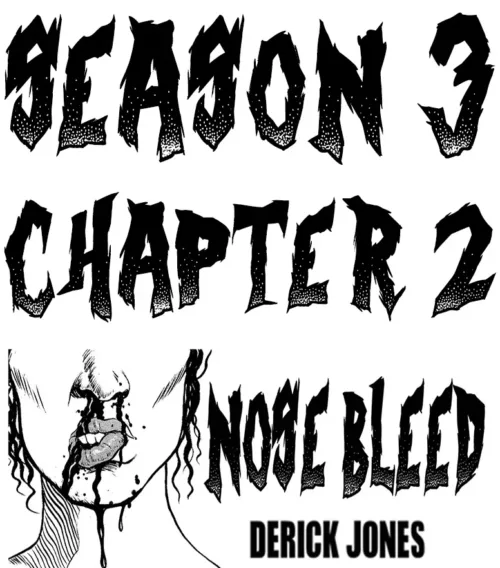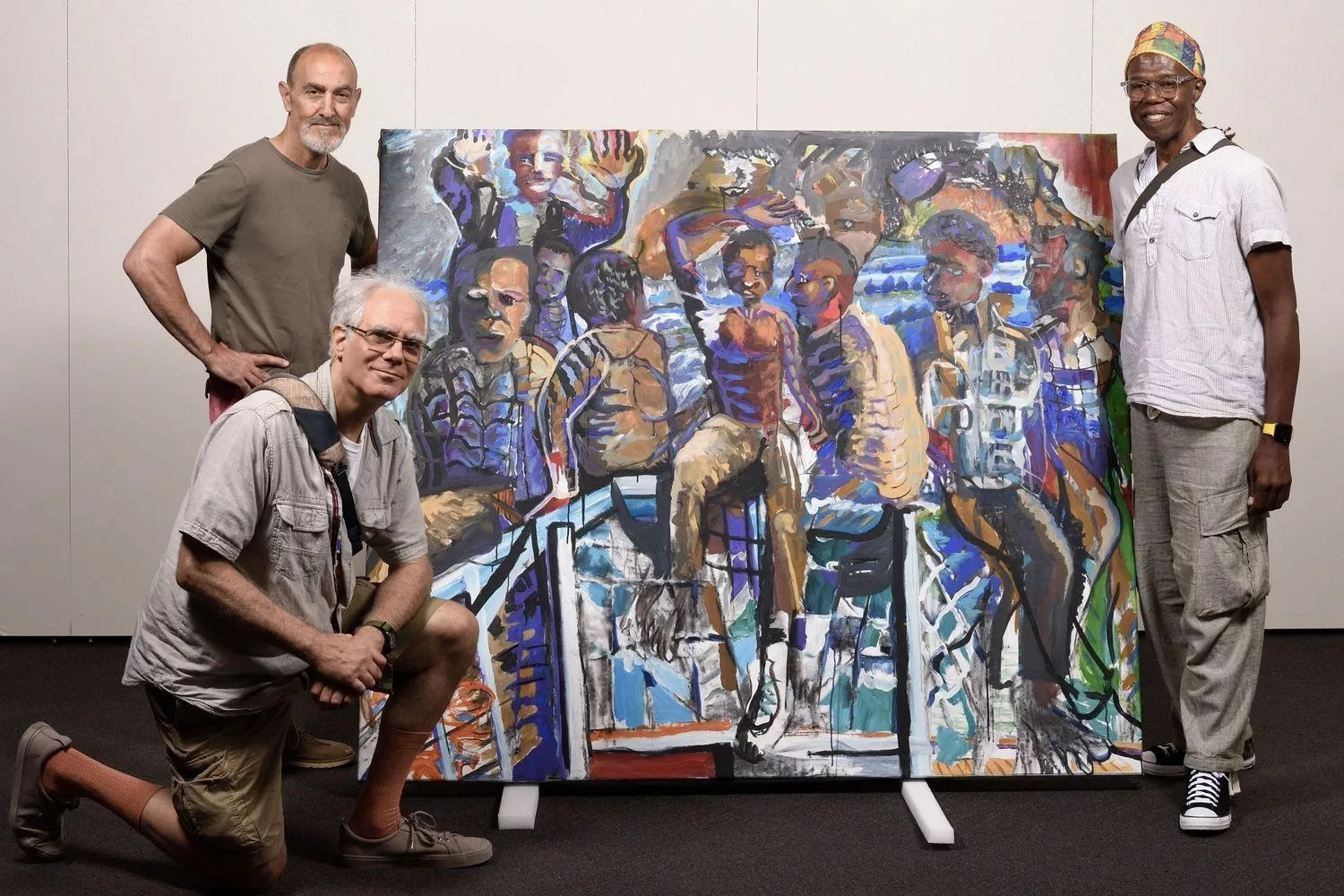
People are social animals. We like to play in groups. In groups, there’s a kind of creative play where we can lose ourselves in a greater goal and become part of something richer and more complex. This group dynamic happens in sports and business, or when a group of musicians fall into the line of an Indian Raga or a jazz ensemble takes flight. Group play is rare among visual artists who typically prefer to tell stories through the lens of their individual practice.
The Kindred Art Collaborative takes a different path. Three artists – Carl Cellini, Richard Metz and Mikel Elam – each with their own mature practice — create work together on one canvas that has a richness and energy that you can trace directly to their process. The Collaborative has a show at PII gallery in Old City opening October 4. In advance of that show I had an opportunity to sit down with the gallerists, and then the Collaborative, to discuss their history and how they set aside their egos and create together.
I first spoke briefly with Margaret Berczynski and her daughter, Aleksandra, at PII; asking them about their story and what they saw in the work of The Collaborative.
Margaret: I opened a gallery in 1990, 34 years ago. Philadelphia was completely different at the time. The building across the street was partially boarded up. I felt very brave (opening the gallery). Because I am from Europe, Poland originally, I wanted to show European artists as well as promising young American artists. For instance, this artist (looking at the show by Elena Drozdova, Riding Fear, September 6th through 28th) was born in Moscow, and immigrated to America some 30 years ago.
In the beginning we had two shows every month. But everything changed when the pandemic came. We (before the pandemic) had shows that sold out; artists from France; 100 or 150 people at an opening. It’s difficult to run a gallery in Philadelphia but I’m optimistic that will change. Now we aim for young professionals, especially in Old City. My daughter started to help me out a few years ago. Now she’s a full-time manager.
Margaret’s daughter represents the continuation of PII’s legacy and brings her own vision and insight to the curatorial process. I asked them about what they saw in the work of Kindred Collaborative.
Aleksandra: One of the things that interested us about the Collaborative, that we became very excited about…was how they compared their work to jazz, how one artist plays off another. The jazz reference really got me, and now I’m very excited to see the work in this space.
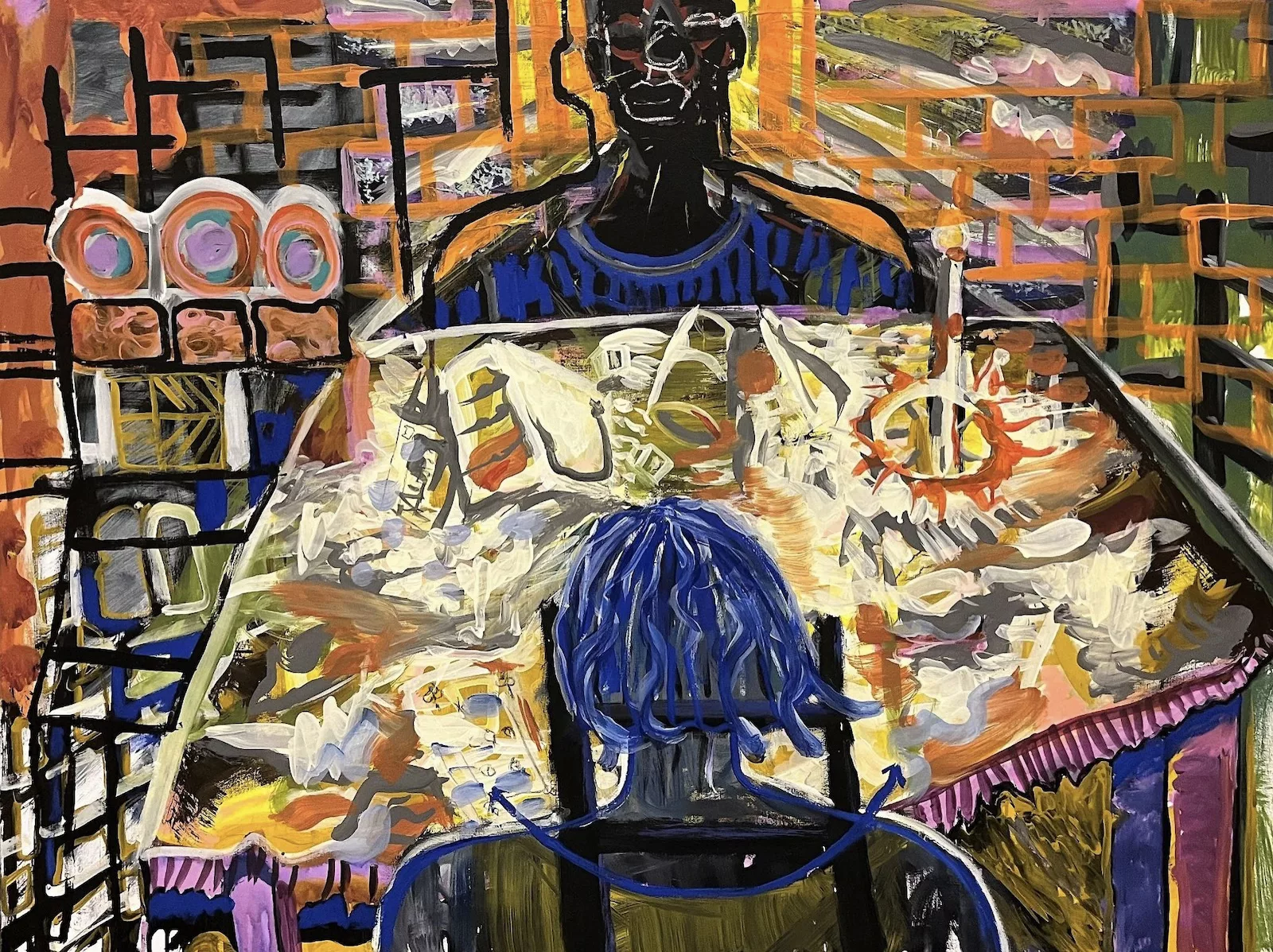
Meeting Carl, Mikel and Richard
After a brief train ride to Ambler, I met Carl Cellini and Mikel Elam in front of Carl’s three story building, which he acquired about 10 years back. His martial arts school is on the first floor. For many years the third floor held a gallery. Now the second is home to the densely packed studio of the Kindred Art Collaborative. Richard Metz joined us a few minutes later and we began our conversation over several cups of black coffee.
Carl’s Story
Carl: I had a lot of engineers on my mom’s side. My sister went to the Philadelphia College of Art. She’s nine years older and (her engagement with art) influenced me. I remember being about ten, and she took me to the basement (of the art school) and these people were doing ceramics and the air was fragrant. They all had long hair. They had great music on, and it was just such a great energy, and that made a huge impact. I thought wow, this is cool. I would love to be part of this.
After high school I went to art school, which is where I met Richard. I went for sculpture, but the painting and drawing teachers were great and just kind of set me on fire. After school Richard and I shared a studio at 1307 Sansom for a year. That was such a great experience, painting and living in the city. I remember seeing a portrait that Richard did of this guy Mikel in 1982, although I didn’t actually meet Mikel until 2016.
About five or six years ago Richard had a show at Cellini Studios (Carl’s gallery). He wanted to pair with someone and decided to invite Mikel. After that – and Richard and I can’t agree on who had this dream, maybe we both did – that we were drawing together. So we started to do that and it was pretty inspiring. Then we said, ‘It’d be great to have a third person.’ Richard thought of Mikel.
Over the years Carl ended up going into computers, earning his living, continuing his sculpting and painting. He studied martial arts, bought the building in Ambler and opened his martial arts school and a gallery.
Mikel’s Story
Mikel: Early on, I didn’t have any idea that I would be an artist. My dad was a civil engineer. I remember him drawing cars, he was a draftsman. Then unfortunately my father passed away suddenly from a heart attack, so it was me and my two brothers and my mother. We ended up moving from Mount Airy to a smaller place in the West Oak Lane section of the city, in Germantown.
I became more introverted. In the third or fourth grade our teacher was showing us watercolors and she kept standing over my shoulder. Finally she said ‘What are you thinking about?’ I didn’t have an answer. At the end of the year, they gave a bulletin board to one student in each class, and my work was chosen. In high school I loved art and I talked to my mom about it and she was like, no, that’s not a good career. There was a shortage of money and I said, ‘Well, if I’m paying for this, I should do what I want to do.’ I ended up at the Philadelphia College of Art.
I heard that teaching could be your backup while you’re trying to be a gallery artist. I got to New York and enrolled at SVA, but New York was really tough. I ended up coming back to Philadelphia, and took a job at this art supply store and that’s where I met Richard. We bonded. It was a really fun time.
Then I had this opportunity, where I got a job with Miles Davis. I was hired because he was drawing and painting on the side while touring and making music. Everything shifted for me. It turned into five years of traveling with him until he passed away. He became a mentor. I thought I was going to show him stuff, but in fact, he showed me discipline.
One day I was working and he says ‘Why aren’t you drawing and painting?’ He had consumed me with his life and I was always tired from all the activities and running to solve something for him. I said ‘I’m too tired.’ He said, ‘No excuses.’ He kept doing that and I finally got back to a practice. I still had no belief in anything I was doing. Plus I was holding back because I didn’t want to kind of destroy his space. And so this happened… I remember this one night in Malibu when we were on our way to Japan. He left the canvas out and said why don’t you work on this? And I was like, ‘I’m not touching that.’ He went to bed and then I’m wide awake and looking at the canvas. I ended up saying, ‘Oh, well, if I mess it up, I get yelled at and that’s it.’
So when all was said and done, those paintings that I worked on with him just kept disappearing. Everything was like that (with Miles) you see it one minute, it’s gone the next. So the show’s coming up and it’s the opening night in Soho. We get in the car, go down (to the show), get out and there’s paparazzi everywhere. I walk into the space and there were the two paintings we did together. (Later) we get back in the car and he says, ‘How did you like to see your work up?’ Then he leaned over and he said, ‘Well, if they sell, I’m gonna give you half.’ (They did sell!).
Then fast forward I’m now working in the art supply store and confidently working as a painter, but I’m painting in the basement of my house. I’m thinking about gallery representation. At a certain point Richard tells me about Carl having this gallery and did I want a show with him? And then that’s how I met Carl.
Then I ended up becoming a manager of that art supply store, which takes us up to last year. The last couple years have been really, really good for me art-wise.
Richard’s story
Richard: I’ve been drawing since I was very young. It was something special for me when I was a child…something that I was good at. My uncle, Frank Metz, is a fairly successful painter, although I wasn’t in contact with him until I was about 16. It seemed very clear to me that I would go into art.
I went to art school a year early, combining my last year in high school with my first year at Tyler. Carl was there. Tyler was like an oasis…it was like I had finally found my people! I was also playing music and having fun in this group with Carl and this older guy, Raymond King, an established Philadelpiha jazz piano player, who also did life modeling at Tyler. We had this jazz trio and then I got involved with a lot of political activities for six or seven years. Environmental activism is (also) very important to me. I get inspired being outside for long periods of time. Sometimes I’m just in the landscape.
I ended up teaching at my old school, Abington High, for 30 years. That was an enormously rewarding experience…to mentor young people. (I found) teaching to be a creative activity; to have wild ideas and see how young people would respond to them. I’m still in touch with some of those people. It was a real honor to see all these incredibly interesting creative minds. Back in 1998 I took a sabbatical and went to Maine with my whole family and did an MFA at Maine College of Art. It was a very good experience and intellectually challenging…having other people telling me what to do with my artwork. It took me a while to recover from that. I think many people have that experience…having to recover from their MFA.
Getting back in touch with Carl and having this dream of us working together has been very interesting. And then incorporating Mikel into it. That’s been interesting because in my personal path I’ve been focused on being outside, focused on landscape. (The group’s work) has a certain kind of wild abstraction. It’s a kind of work I’ve always wanted to do. So this is really fulfilling, enormously influential for me and kind of challenging.
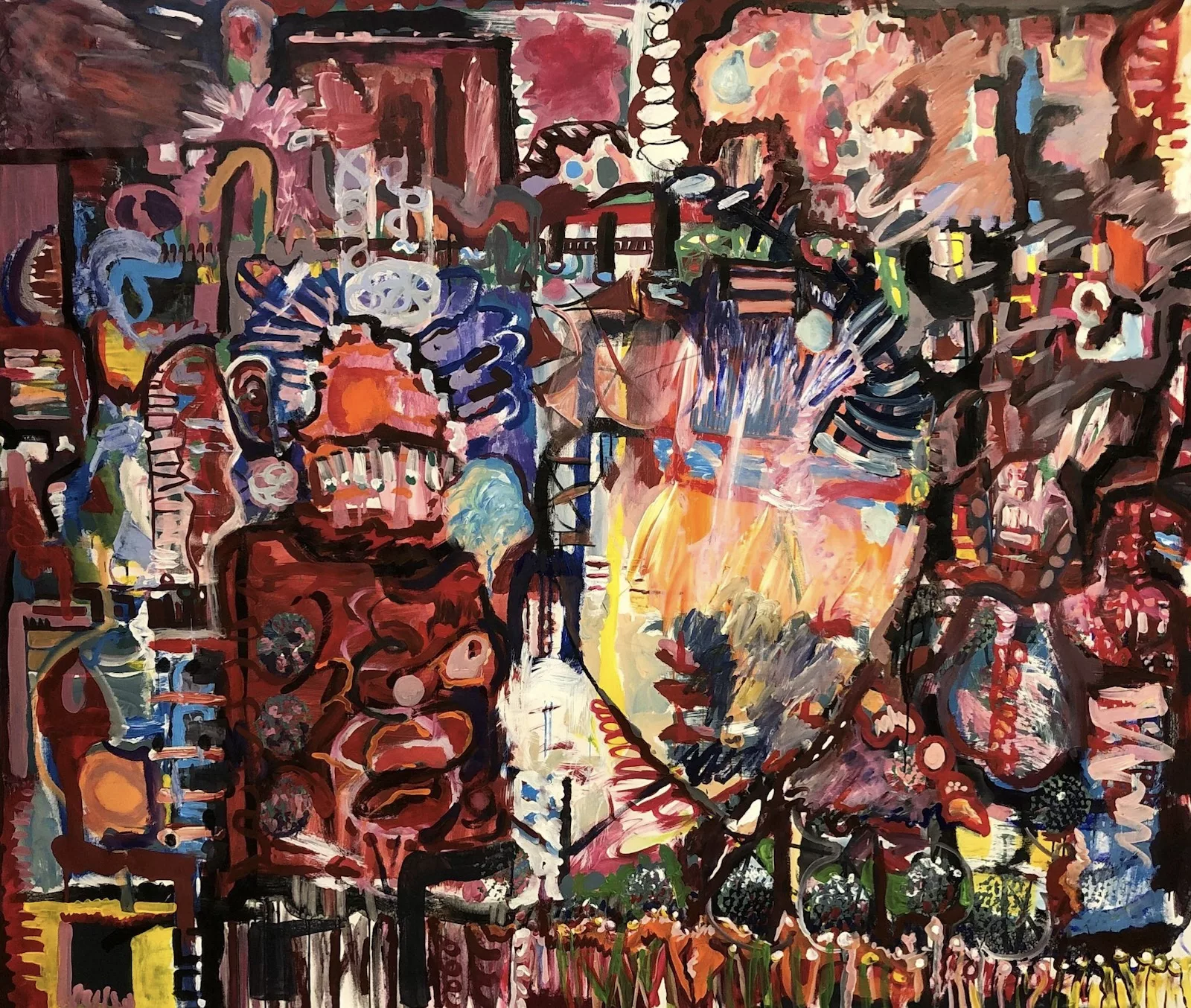
The Kindred Story; the fourth member of the group
We finished our discussion by talking about their joint process. I’ll leave out the attribution for the text below to respect the Collaborative’s spirit and process.
The Collaborative: When there are four people playing music, the music becomes like a place. And each person is continuing that place, and you know what to do. But it’s a visual language so it’s hard to talk about. It’s pretty hard to explain the mood of a Miles Davis piece. Ultimately you can’t reduce it to words. I think with our process it’s similar, it’s this wonderful collaboration. There’s the three of us and then there’s this fourth, which is Kindred. But it isn’t a full blown identity. (Gesturing towards a large painting) we see Kindred and there it is. It’s invisible. It’s the three of us together.
We all have a responsibility once we’re in this space. I can’t drop the ball. If I’m alone, I can drop the ball, but when I’m working with these guys I have to keep up my end. Mikel says it’s good to be uncomfortable, and I get uncomfortable all the time when we’re doing stuff. But what’s so exciting is that the other two will do something that I would never have anticipated.
.
One of the things that we do in our process is we tell stories to each other about growing up. Usually, before we paint, we’ll sit around for an hour and talk. I have known these two guys for 40 years. We have that trust and depth, which gives us the freedom to do what we’re doing because we know each other, and there’s still so much more to know, It’s the natural process of our friendship. That leads us to trusting each other in the mark making process.When you have a jazz ensemble each person knows their role. There’s the bass player and so on. With us, we don’t really know who has what instrument. There’s no drummer, no bass player. So finding the right space in the right frequency is challenging. But it’s also very exciting. Sometimes Richard might be the trumpet player, and, if that’s the case then maybe I have to be a quiet cymbal. Or maybe they’re doing something quiet and I need to just get on the horns. So then they’re kind of shocked. ‘Oh my gosh, where’d that come from? What am I gonna do now?’
Postscript
When The Collaborative starts a work, any of the three may make the first mark.They may have several works in process simultaneously. If you saw them at work they say their interaction would look like an improvisational dance. That dance continues over several, 5- or 6-hour sessions until the piece and the group come to rest. To see the results of their unique process pay a visit to PII in the coming weeks.
Kindred Art Collaborative at PII Gallery
242 Race Street
October 4th through the 26th
Opening reception: Friday, October 4th, 5:00pm to 9:00pm



